Condiciones de trabajo de los pediatras de Atención Primaria
Reyes Hernández Guilléna, Begoña Domínguez Aurrecoecheab, N Sánchez Corderoc
aPediatra. CS El Naranjo. Fuenlabrada. Madrid. España.
bPediatra. Instituto de Investigación Sanitaria del Principado de Asturias (ISPA). Asturias. España.
cPediatra. CS Alicante. Fuenlabrada. Madrid. España.
Correspondencia: R Hernández. Correo electrónico: reyeshdez@gmail.com
Cómo citar este artículo: Hernández Guillén R, Domínguez Aurrecoechea B, Sánchez Cordero N. Condiciones de trabajo de los pediatras de Atención Primaria. Rev Pediatr Aten Primaria. 2014;16:21.e1-e18.
Publicado en Internet: 14-04-2014 - Número de visitas: 25219
Resumen
Introducción: en el sistema público de salud, la población debería ser el centro del sistema y el profesional sanitario su principal activo; garantizar que el encuentro asistencial se realice bajo unas condiciones de calidad es fundamental en la organización y diseño de los sistemas sanitarios. Conocer la realidad de los Equipos de Atención Primaria (EAP) y las condiciones de trabajo de los pediatras de Atención Primaria (PAP) resulta imprescindible para poder ofrecer una mejor asistencia a nuestros pacientes. El objetivo es conocer las condiciones del lugar de trabajo y los medios y recursos disponibles, las cargas de trabajo, la autonomía de gestión y la conciliación de la vida familiar y laboral.
Material y métodos: estudio observacional descriptivo mediante encuesta realizada on-line a PAP en España a través de la lista de distribución PEDIAP y de la lista de correo de la Asociación Española de Pediatría de Atención Primaria (AEPap) en diciembre de 2012.
Resultados: recogidas 809 respuestas de todas las comunidades autónomas (CC. AA.) de un total de 6258 plazas de PAP. Un 40,6% opina que las condiciones de la consulta no permiten una correcta realización de su trabajo. El 50% no tiene acceso a las pruebas complementarias que considera necesarias. Ocho de cada diez dedican más del 75% de su jornada a labores exclusivamente asistenciales. Hasta un tercio de los pediatras tiene que asumir la consulta completa del compañero durante periodos prolongados por falta de cobertura con suplentes. Casi el 80% considera que existen condiciones que facilitan la conciliación de la vida familiar y laboral. Solo el 28% de los equipos tiene capacidad para autogestionar el presupuesto asignado a suplencias. Existen diferencias importantes para todos los ítems estudiados entre las distintas CC. AA.
Conclusiones: las condiciones laborales de los PAP distan de cumplir unos requisitos que aseguren una correcta atención clínica. La escasa capacidad de participación en la gestión sitúa las posibilidades de mejora fuera de los PAP e incluso de los propios EAP.
Palabras clave
● Atención Primaria ● Condiciones laborales ● Pediatría ● Situación laboralINTRODUCCIÓN
En el sistema público de salud, la población debería ser el centro del sistema y el profesional sanitario su principal activo. Garantizar que el encuentro asistencial se realice bajo unas condiciones de calidad es fundamental en la organización y diseño de los sistemas sanitarios1.
Conocer la realidad de los Equipos de Atención Primaria (EAP) y las condiciones de trabajo de los pediatras de Atención Primaria (PAP) resulta imprescindible para poder ofrecer una mejor asistencia a nuestros pacientes. Bajo esta premisa, el Foro de Atención Primaria (que aglutina a todas las organizaciones profesionales de médicos de Atención Primaria [AP] de ámbito estatal) decidió abordar la problemática de la situación laboral de los médicos en AP, y desde la Asociación Española de Pediatría de Atención Primaria (AEPap) nos hicimos las siguientes preguntas: a) ¿en qué condiciones están trabajando los PAP?; b) ¿son las condiciones físicas de las consultas las más idóneas para una correcta asistencia médica de sus pacientes y para preservar la salud del profesional?; c) ¿el pediatra cuenta con los recursos suficientes tanto para atender a sus pacientes como para mantener y mejorar sus conocimientos?; d) ¿dispone de la suficiente autonomía para sentirse partícipe del proceso organizativo que condiciona la forma de atención?; e) ¿el profesional tiene algún tipo de incentivo adecuado que mejore su implicación en el sistema redundando en una mejora de la asistencia?
En el año 2011, la AEPap ya realizó una encuesta a 16 pediatras expertos con el fin de conocer la situación de la asistencia a la población infantojuvenil en AP en las distintas comunidades autónomas (CC. AA.) españolas2,3, donde ya se recogían algunos problemas graves relacionados con la situación laboral de los PAP e importantes discrepancias entre las distintas CC. AA.
Así mismo, en 2012, la AEPap se planteó ampliar dicho estudio realizando una encuesta a los propios profesionales que se ha publicado recientemente en la Revista de Pediatría de Atención Primaria4.
Con esta nueva encuesta, hemos pretendido completar y ampliar algunos de los aspectos específicamente relacionados con las condiciones laborales, intentando aportar la visión y las características específicas de los PAP dentro del Foro de Atención Primaria.
MATERIAL Y MÉTODOS
Se realizó una encuesta on-line mediante un formulario Google-Docs®. Se divulgó entre los médicos que trabajan de PAP a través de la lista de correo nacional de socios de la AEPap y de la lista de distribución PEDIAP durante la semana del 3 al 9 de diciembre de 2012 y dirigida a pediatras de todas las CC. AA., cuyas contestaciones eran anónimas.
Las preguntas versaban fundamentalmente sobre las condiciones del lugar de trabajo, los medios y los recursos de los que se dispone en la consulta, la distribución de los tiempos en la jornada laboral, aspectos relacionados con la conciliación de la vida familiar y laboral, el grado de autonomía en la gestión de los aspectos organizativos de la consulta, y los métodos de incentivación y la posibilidad de implicación en los mismos. Dado que, unos meses antes, desde la AEPap ya se había enviado una encuesta (encuesta PAPE) en la que se recogían aspectos relacionados con las cargas de trabajo, no se hicieron preguntas relacionadas con este tema, pero en este artículo se mostrarán los resultados de dicha encuesta relacionados con ese punto concreto, y que también están accesibles en http://goo.gl/LptxKT
Se recibieron un total de 809 respuestas, que supone conocer la opinión de un 13% de los 6258 PAP. Aunque la técnica de muestreo no permite realizar una inferencia estadística, ya que está sujeta a múltiples sesgos, creemos que aporta datos interesantes en el conocimiento de las condiciones laborales de los PAP y puede servir como base para profundizar en algunos de sus aspectos.
RESULTADOS
Con respecto a las respuestas obtenidas en cada comunidad autónoma, el porcentaje sobre el total de PAP y el relativo a cada comunidad se pueden observar en la Tabla 1. Las CC. AA. con mayor porcentaje de pediatras respondedores en relación al total de pediatras en esa comunidad son el Principado de Asturias, Euskadi, La Rioja y Cantabria. Las de menor participación son Cataluña, la Comunidad Valenciana, las Islas Baleares y las Islas Canarias.
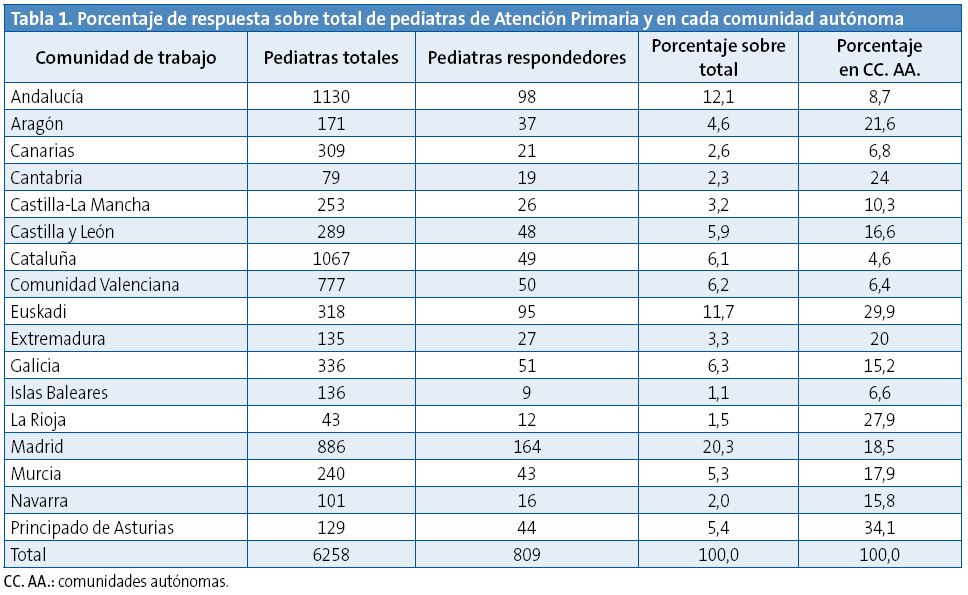
Condiciones del lugar de trabajo, medios y recursos
- ¿Las condiciones de la consulta permiten una correcta realización del trabajo? El 40,6% de los PAP considera que las condiciones de su consulta no permiten una correcta realización de su trabajo. Por CC. AA., la que peor se sitúa con respecto a este punto es La Rioja (58% de condiciones inadecuadas), seguida por Andalucía y la Comunidad Valenciana (56%). La que presenta unas condiciones más adecuadas es Navarra (81% de condiciones adecuadas), seguida de Cantabria (79%) (Fig. 1).
- Tipo de condiciones negativas: el 61% de los pediatras consideran que las medidas de seguridad ante posibles conflictos (timbre de pánico, correcta colocación de la mesa en la consulta, etc.) no son las necesarias. El 52% no tiene los elementos ergonómicos adecuados en su consulta (silla, colocación del ordenador, etc.). El 51% tiene una temperatura incorrecta y el 34% no tiene ventilación en su consulta. Un 37% considera que no tiene el material necesario para una correcta exploración (otoscopio, oftalmoscopio, camilla adecuada, etc.).
Además, se han señalado otras deficiencias de manera aislada, sin poder establecer el porcentaje, pero que reflejan unas condiciones del lugar de trabajo muy deficientes en algunas ocasiones:
- Condiciones físicas del lugar de trabajo:
- Demasiado ruido (colocación inadecuada del lugar de la consulta al lado del mostrador, zumbido del sistema de climatización, equipo informático muy ruidoso).
- Iluminación inadecuada y sistema eléctrico deficiente y anticuado (con cables y enchufes accesibles a los niños).
- Humedades.
- Falta de lavabo en la consulta.
- Paredes sucias (sin pintar desde hace 15 años), desconchadas, con grietas, con humedades (varias respuestas coincidentes).
- Sala de espera y consulta pequeñas (con los carritos de los niños solo cabe una silla) (varias respuestas coincidentes).
- Limpieza deficiente (varias respuestas coincidentes).
- No salida de emergencias (varias respuestas coincidentes).
- Necesidad de compartir consulta (varias respuestas coincidentes).
- Déficit de recursos materiales:
- Camilla sin posibilidad de regulación en altura para poder trabajar mejor el profesional y falta de peldaños para que puedan subir los niños.
- No lavado de la ropa de trabajo.
- Material de escritorio, etc., anticuado y en mal estado.
- Tallímetro roto y no arreglado.
- Falta de material necesario, com: negatoscopio, fonendoscopio, antitérmicos en consulta, test rápido de estreptococo, escasez de material fungible, pulsioxímetros adecuados para lactantes, esfigmomanómetros para menores de cuatro años, otoscopio neumático, sondas para extraer cuerpos extraños, empapadores, depresores pésimos (se astillan), escasez de material para una urgencia vital (ambú solo para adultos, falta de agujas intraóseas, escasez de material para suturas).
- Condiciones físicas del lugar de trabajo:
- Acceso a biblioteca: el acceso a alguna biblioteca (virtual o física) que proporcione material bibliográfico lo tiene el 76,6% de los pediatras. Para el trabajo, tanto asistencial, como docente e investigador, es fundamental este recurso que casi una cuarta parte de los profesionales no lo tiene.
Por CC. AA., la mejor situada es La Rioja, donde todos los profesionales tienen acceso, seguida por Extremadura (96,3%), Galicia (95,9%), Euskadi (90,5%) y Cataluña (89,6%). La peor de las comunidades en este aspecto es la Comunidad Valenciana (48%), seguida por Canarias (42,9%) y Andalucía (41,5%) (Fig. 2).
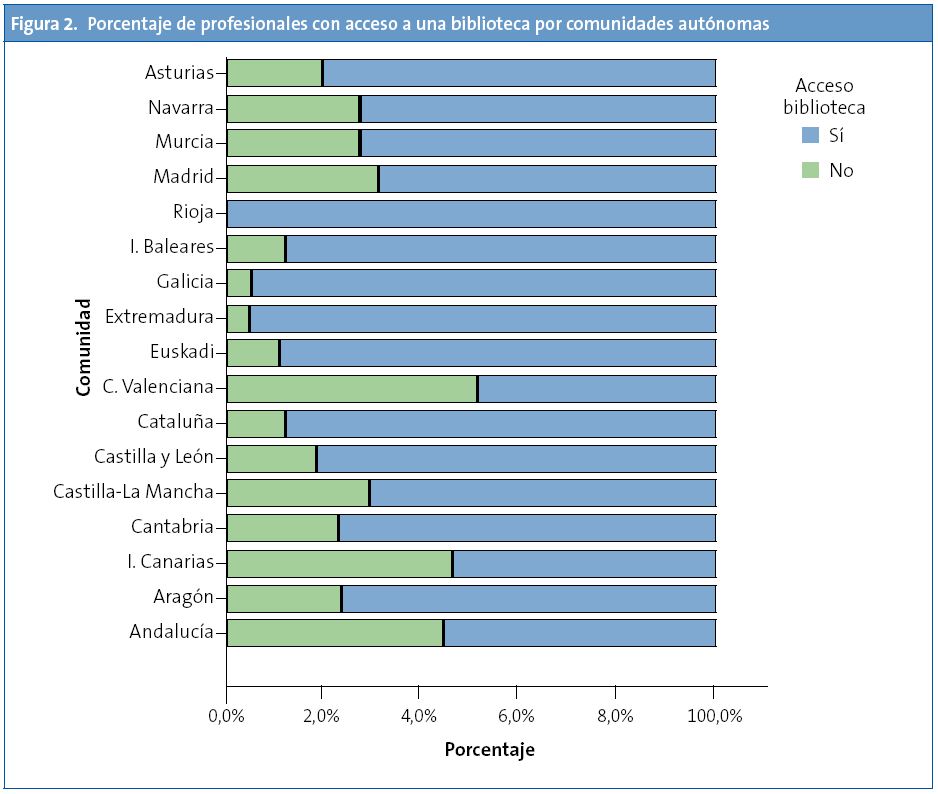
- Servicio de investigación: solo un 30% de los profesionales tienen acceso a algún servicio de investigación accesible que le ayude en sus posibles investigaciones, lo cual dificulta enormemente la realización de trabajos de investigación en AP.
Las Islas Baleares son las que más ayuda ofrecen a sus profesionales para la investigación (66,7%). Le siguen las comunidades de Cataluña (54,2%), Aragón (50%) y Castilla-La Mancha (47,8%). Las comunidades que menos apoyan la investigación en AP son La Rioja (solo tiene acceso un 8,3% de los profesionales) y Andalucía (13,2%) (Fig. 3).
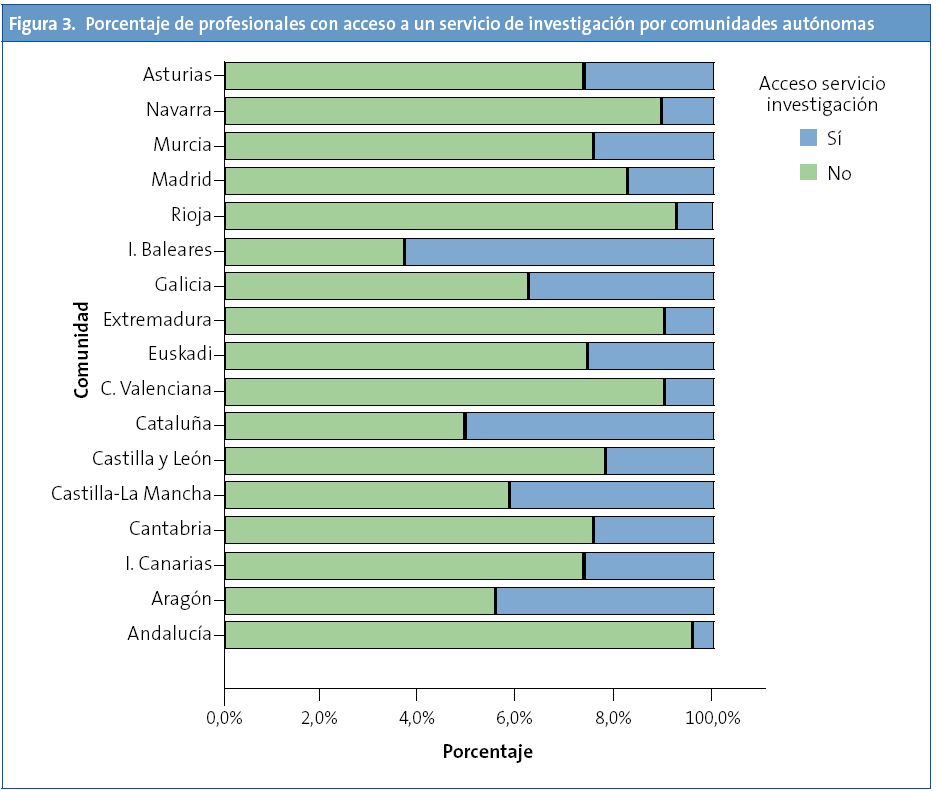
- Acceso a pruebas complementarias: el 52,7% de los pediatras indica que no tiene acceso a pruebas complementarias que considera necesarias y accesibles desde AP. El 17,9% tiene acceso a todas las pruebas que necesita pero en ocasiones a través de un protocolo, y solo el 29,4% tiene acceso libre a cualquier exploración complementaria que precise (datos de la encuesta PAPE).
- Acceso a Internet e historia clínica electrónica: el 86% de los profesionales tiene acceso a Internet, aunque dos terceras partes de ellos con muchas restricciones. Casi la totalidad de los pediatras (98,7%) dispone de historia electrónica, pero el 33,7% considera que es poco completa o de acceso lento o complicado (datos de la encuesta PAPE).
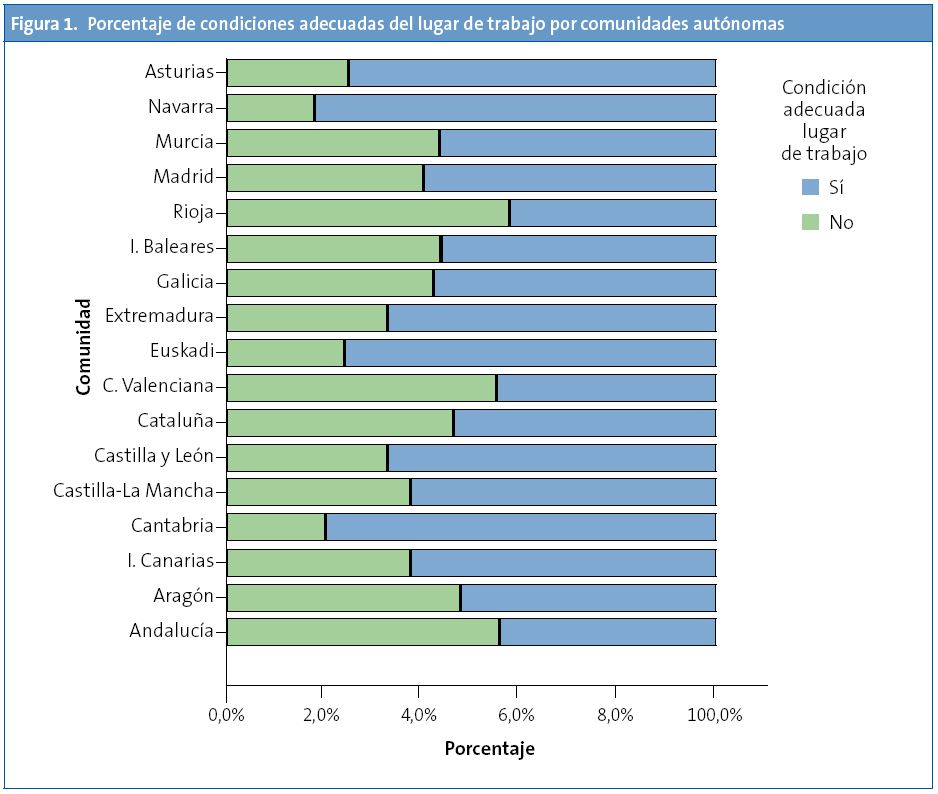
Distribución de tiempos en la jornada laboral
- Porcentaje de la jornada laboral dedicada a labores asistenciales: el 78,6% de los pediatras dedica más del 75% de su jornada a tareas exclusivamente asistenciales, por lo tanto no pueden dedicar tiempo a tareas docentes, de investigación, de formación u organizativas.
En este sentido, las peores CC. AA. son La Rioja (el 91,7% de los pediatras dedica más del 75% de su jornada a tareas asistenciales) y Cataluña (89,8%). Las mejores son Principado de Asturias (61,4%) y Castilla y León (64,6%) (Fig. 4).
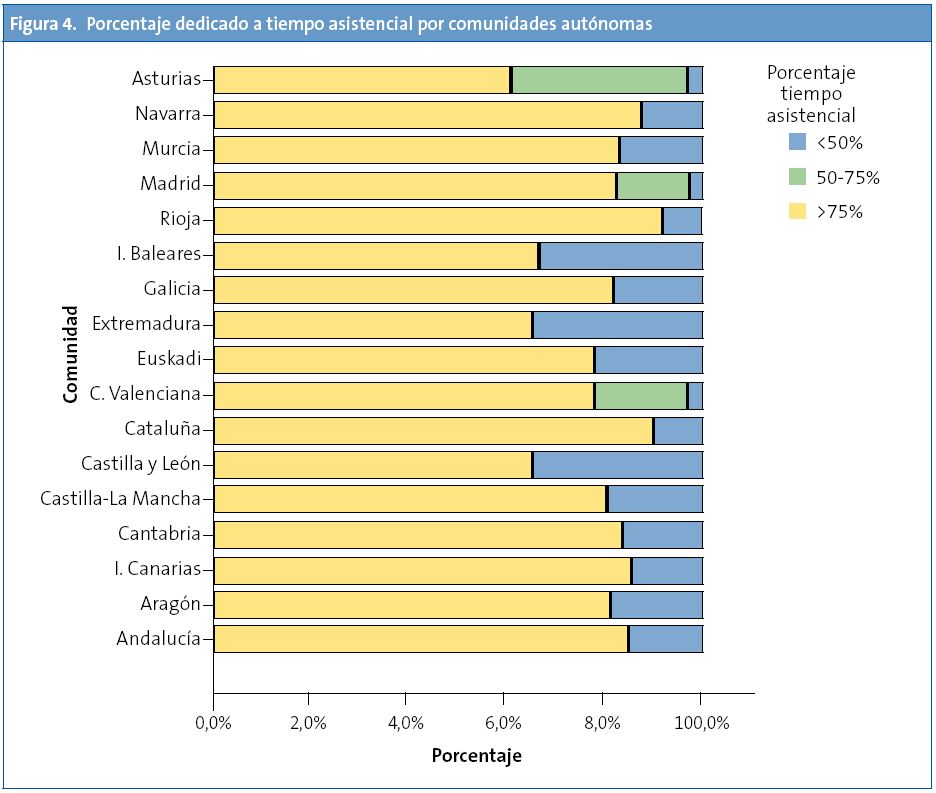
- Frecuencia de sesiones clínicas y formativas en el centro de salud (CS): la gran mayoría (hasta un 60%) realiza sesiones clínicas y formativas en su CS solo de forma aislada alguna vez al mes. Solo el 25,5% de los pediatras realiza una sesión semanal.
El Principado de Asturias es la comunidad que tiene mayor porcentaje de pediatras que realizan al menos una sesión clínica al mes (39%). Las que menor porcentaje reflejan en este punto son La Rioja (10%) y Navarra (12,5%) (Fig. 5).
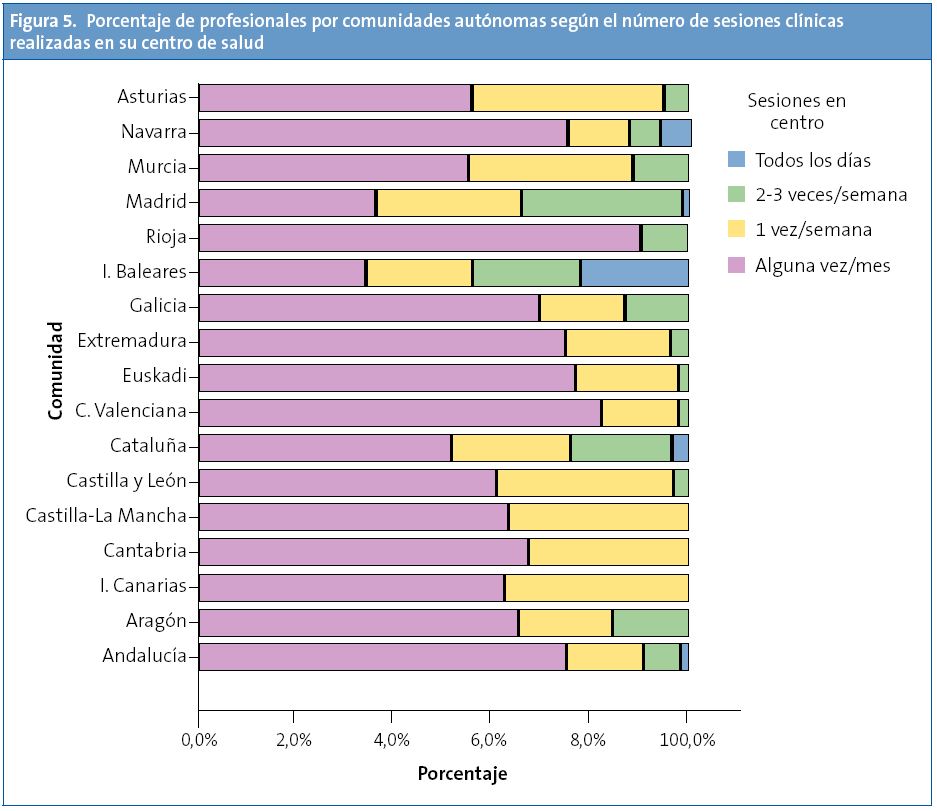
Cargas de trabajo
- Pacientes adscritos al CIAS de Pediatría (datos de encuesta PAPE): el 60% de los pediatras tiene un cupo con más de 1000 niños asignados (Tabla 2). Considerando la propuesta de las asociaciones profesionales de un número óptimo de pacientes por plaza de Pediatría de 800 a 1000 niños menores de 14 años, podemos decir que la situación es de cupos sobredimensionados.
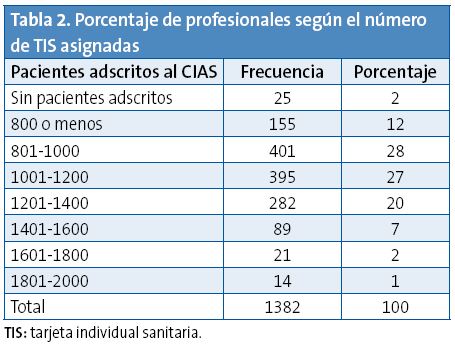
- Presión asistencial (media de pacientes vistos al día): un 45% tiene una media superior a 30 pacientes asistidos al día (Tabla 3); muy por encima del número adecuado que garantice un adecuado desarrollo del proceso clínico (datos de la encuesta PAPE).
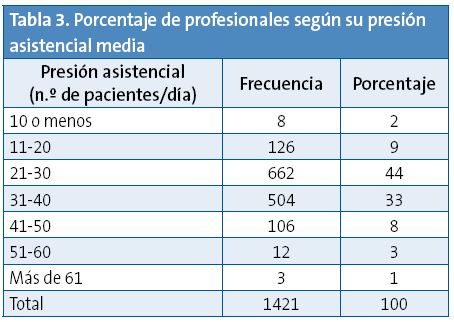
- Carga de trabajo por suplencias: es evidente que la sobrecarga del pediatra por tener que asumir las consultas de compañeros ausentes es muy elevada, ya que casi un tercio de ellos (un 32,1%) ha tenido que pasar la consulta completa del compañero (es decir, dos consultas completas) y un 22,9% parte de una consulta durante periodos largos (Fig. 6). Esta es una particularidad de la PAP que no se da en el resto de categorías.
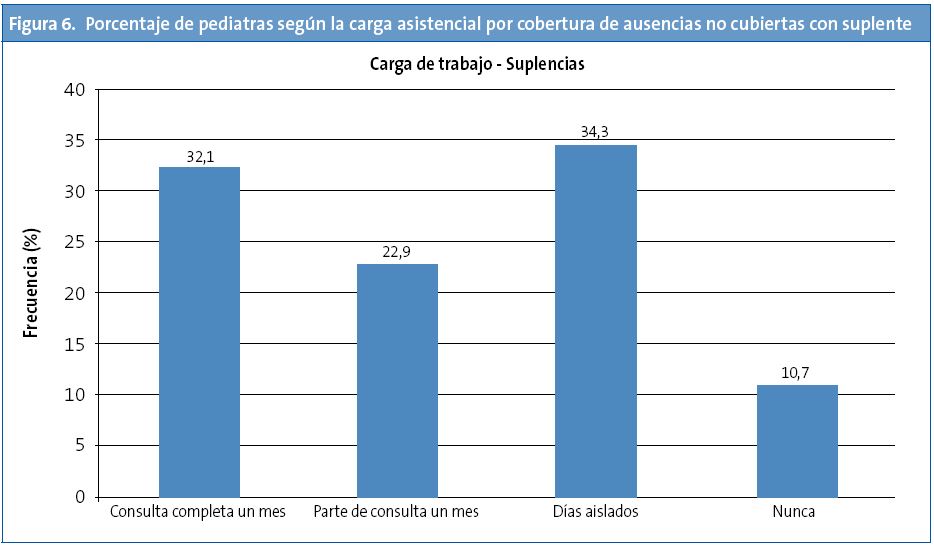
Las comunidades en las que más carga soportan sus pediatras en relación con este aspecto son La Rioja (el 66,7% tiene que pasar la consulta completa de un compañero ausente durante al menos un mes), Cantabria (47,4%), Andalucía (41,7%) y Extremadura (40%). La mejor situada es Aragón (tan solo un 2,7%), seguida por Euskadi (20%), las Islas Baleares (22,2%) y Cataluña (22,4%) (Fig. 7).
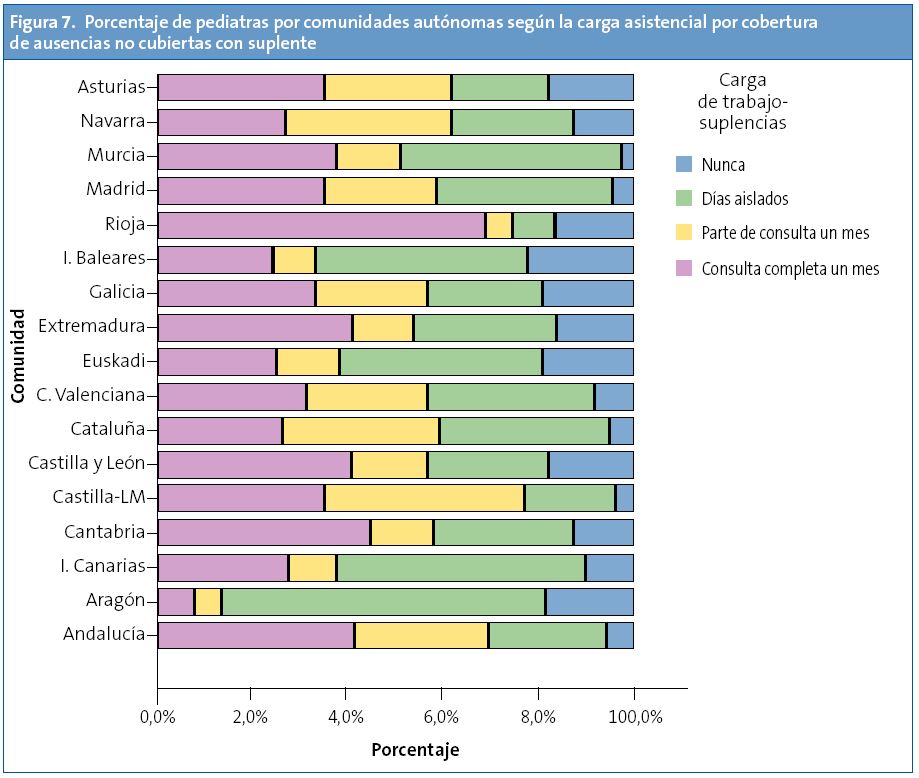
- Existencia de receta electrónica (como parte de un proceso que descargue de la burocratización): casi un 40% de los profesionales todavía no dispone de receta electrónica en su consulta.
En este punto existen diferencias muy importantes entre las distintas CC. AA. Algunas tienen instaurada la receta electrónica completamente o casi en su totalidad (Andalucía, Canarias, Cantabria, Cataluña, Comunidad Valenciana, Extremadura, Galicia e Islas Baleares). Sin embargo, algunas comunidades llevan un gran retraso en conseguir esta importante herramienta, entre las que se encuentran Madrid, Castilla-La Mancha, Murcia y el Principado de Asturias (Fig. 8).
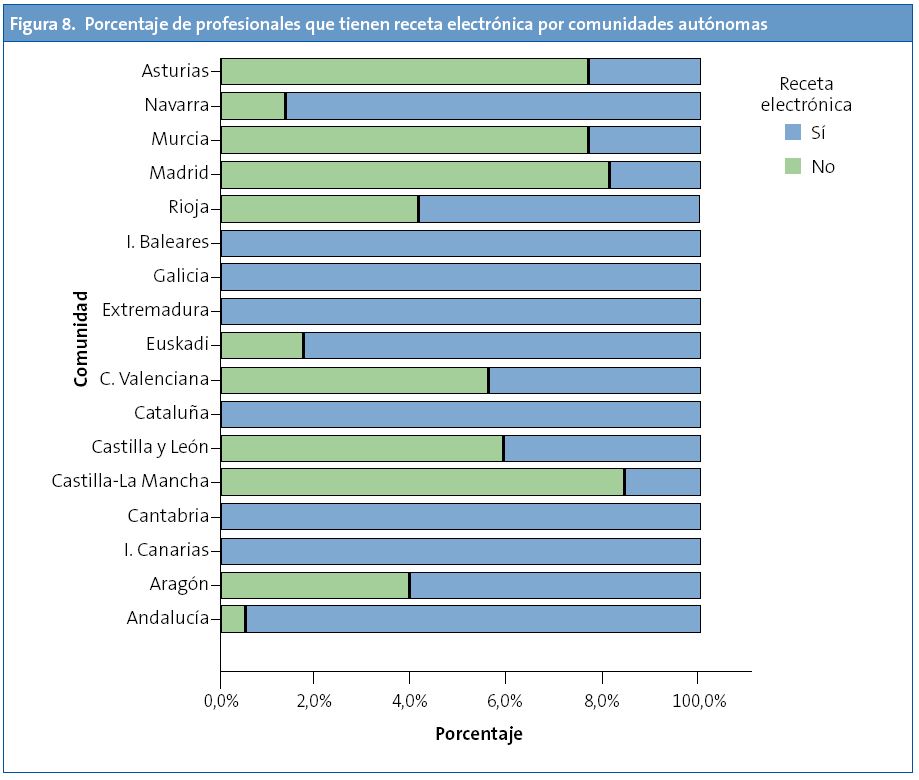
Conciliación de la vida familiar y laboral
- Existencia de conciliación de la vida familiar y laboral: un 78,9% de los profesionales considera que tiene un horario y unas condiciones laborales que le permiten conciliar correctamente la vida familiar y laboral.
Las CC. AA. donde los profesionales sienten que tienen más dificultades para conciliar estos aspectos son Navarra (el 50% no pueden conciliar) y Cantabria (36,8%) (Fig. 9).
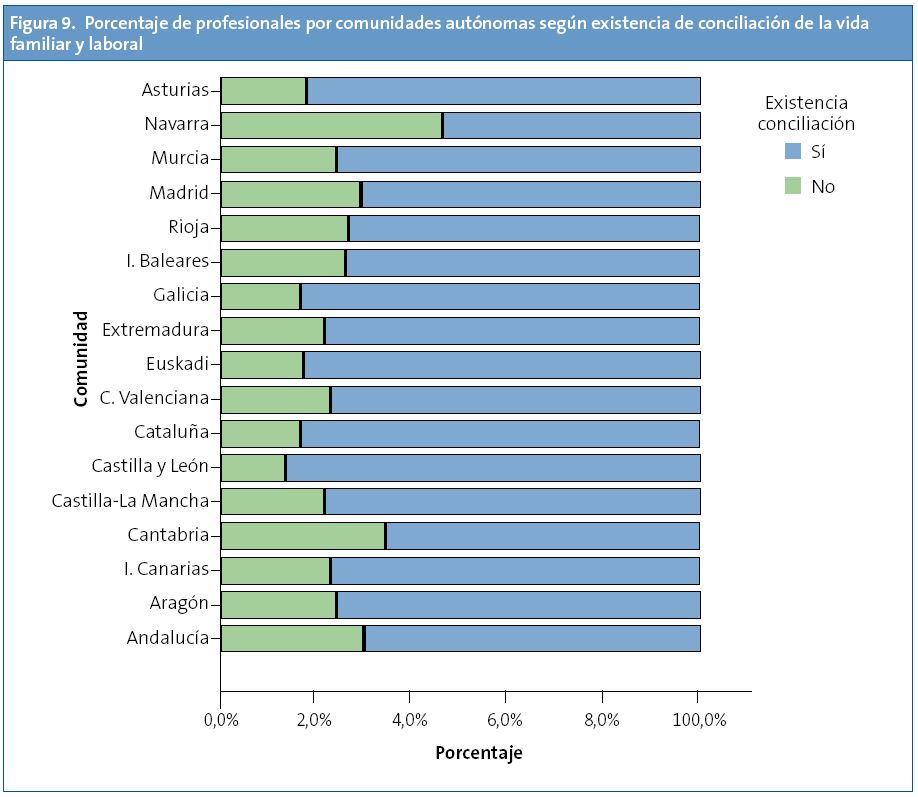
- Problemas que impiden la correcta conciliación familiar y laboral: de los que consideran que no pueden conciliar bien su vida familiar y laboral, el mayor porcentaje (casi el 89,4%) indica que ello se debe a que tiene un turno fijo en el horario en que debería ocuparse de su familia. Las comunidades con un menor porcentaje de profesionales con un turno fijo que impide su correcta conciliación son Navarra y Cantabria (Fig. 10).
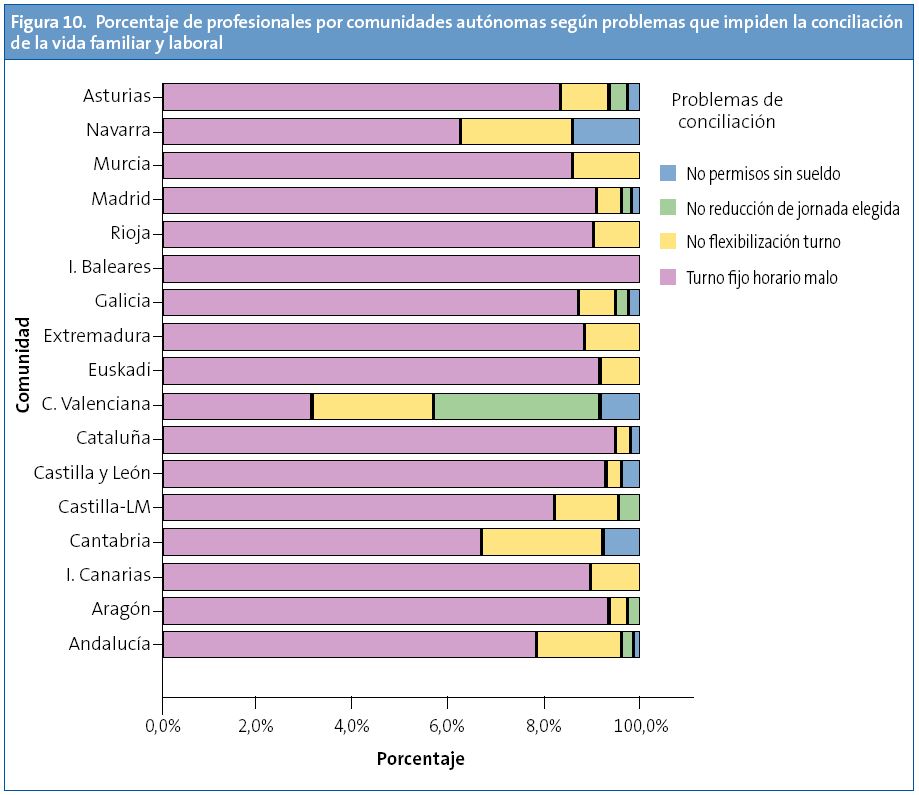
Autonomía de gestión
- Gestión de la agenda: parece preocupante que hasta un 24,5% de los PAP no haya podido participar en el diseño de su agenda, dado que es el instrumento que puede utilizar el profesional para organizar sus tiempos de trabajo y conseguir una mejor atención al paciente.
Las CC. AA. en las que menos han podido participar han sido Canarias (47,6% de no participación), Andalucía (40%), Cataluña (37,4%) y las Islas Baleares (33,6%). En las que más participan son Castilla-La Mancha (96,2% de participación), Aragón (94,6%) y Extremadura (92,6%) (Fig. 11).
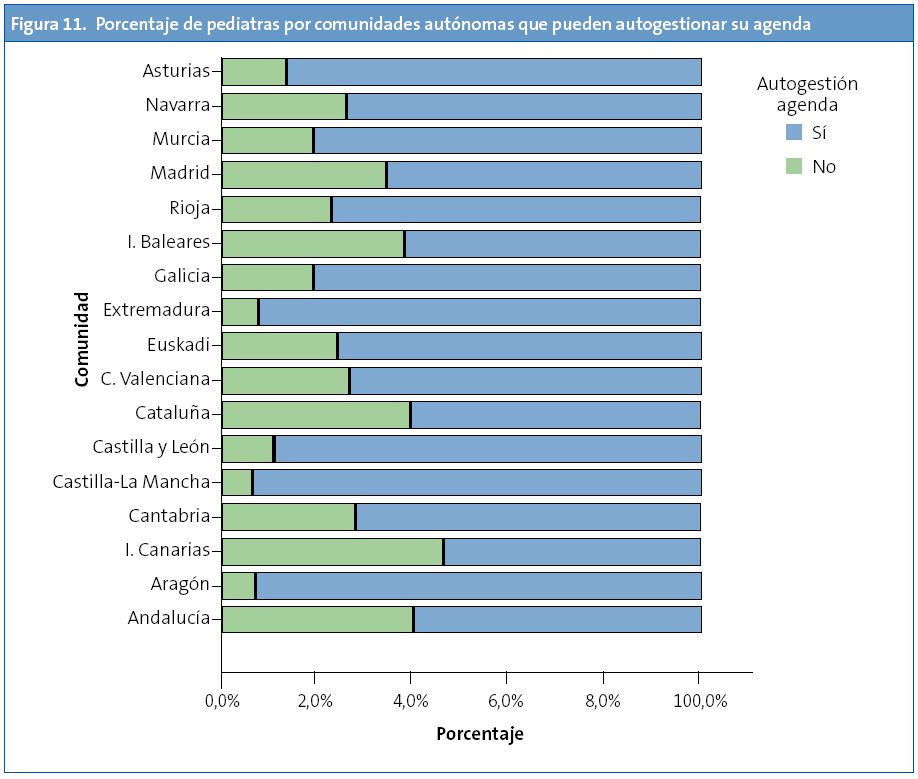
- Autogestión del equipo en suplencias: solo un 28,3% de los EAP tiene capacidad para autogestionar el presupuesto asignado a suplencias.
En algunas comunidades, esta capacidad de autogestión es nula o casi nula, como en Canarias y La Rioja (0%), en Murcia (4,9%), en Galicia (5,9%) y en el Principado de Asturias (6,8%). En otras se ha avanzado más en este aspecto, entre las que destacan Madrid (75%) y Aragón (70,3%) (Fig. 12).
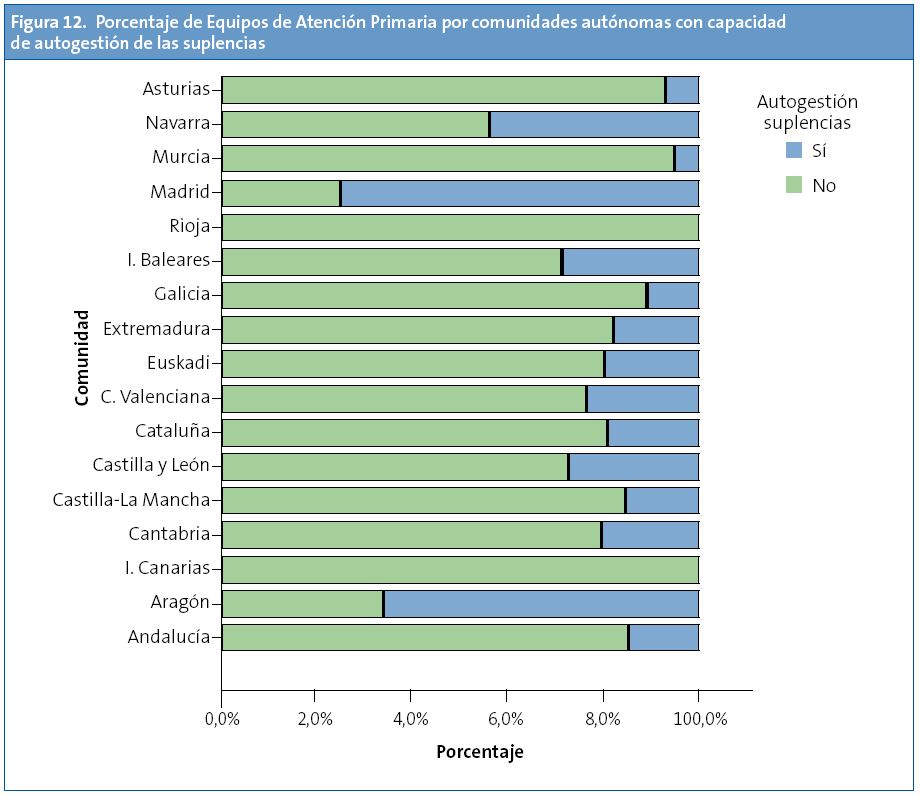
- Conocimiento de indicadores valorados en productividad variable al comienzo del año: de media, hasta un 65,5% de los pediatras no conocía a principio de año los ítems que se iban a valorar para la consecución de objetivos de cara a la productividad variable, lo cual invalida completamente el objetivo para el que se supone que están concebidos.
Las peores CC. AA. son La Rioja (la totalidad de los pediatras desconocía los ítems a valorar), Cantabria (94,4%), Murcia (92,9%) y Castilla-La Mancha (92%), y las mejores, Canarias (14,3%), Castilla y León (41,7%), Andalucía (43,2%) y la Comunidad Valenciana (44%) (Fig. 13).
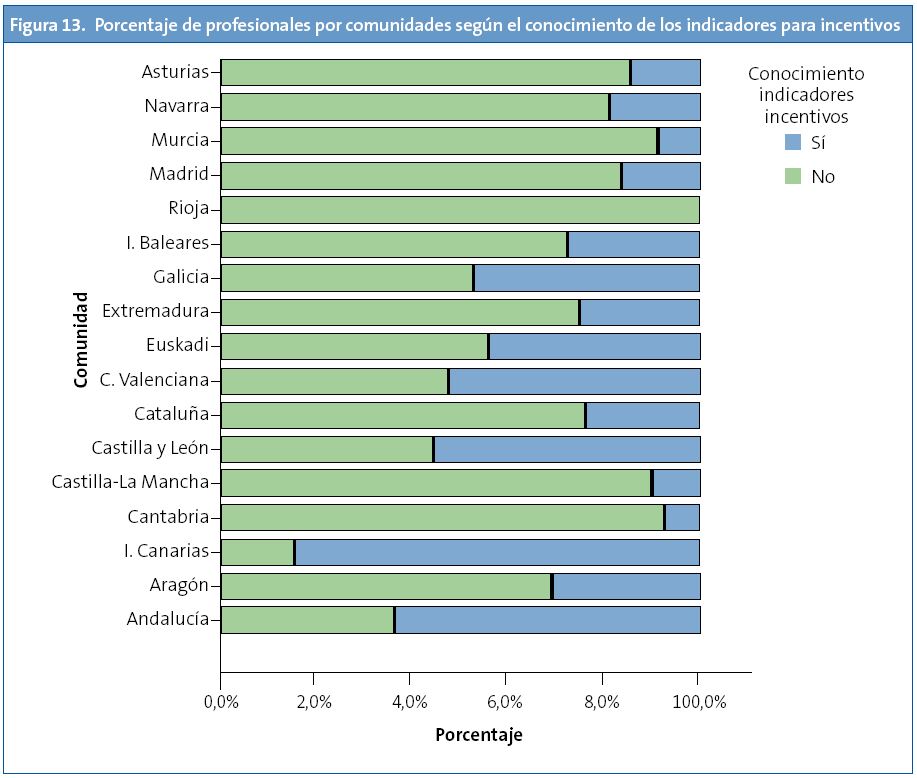
- Participación en negociación de la productividad variable: pero, aún peor, solo un 9,5% de los profesionales había podido negociar los indicadores utilizados para la valoración de objetivos de cara a la productividad variable.
En algunas CC. AA. no han podido negociar nada en absoluto: Aragón, Cantabria, Castilla-La Mancha, La Rioja, Murcia y Navarra. La Comunidad Valenciana solo en un 2%. Las que más han negociado han sido Canarias (42,9%), Cataluña (33,3%) y Galicia (29,4%) (Fig. 14).
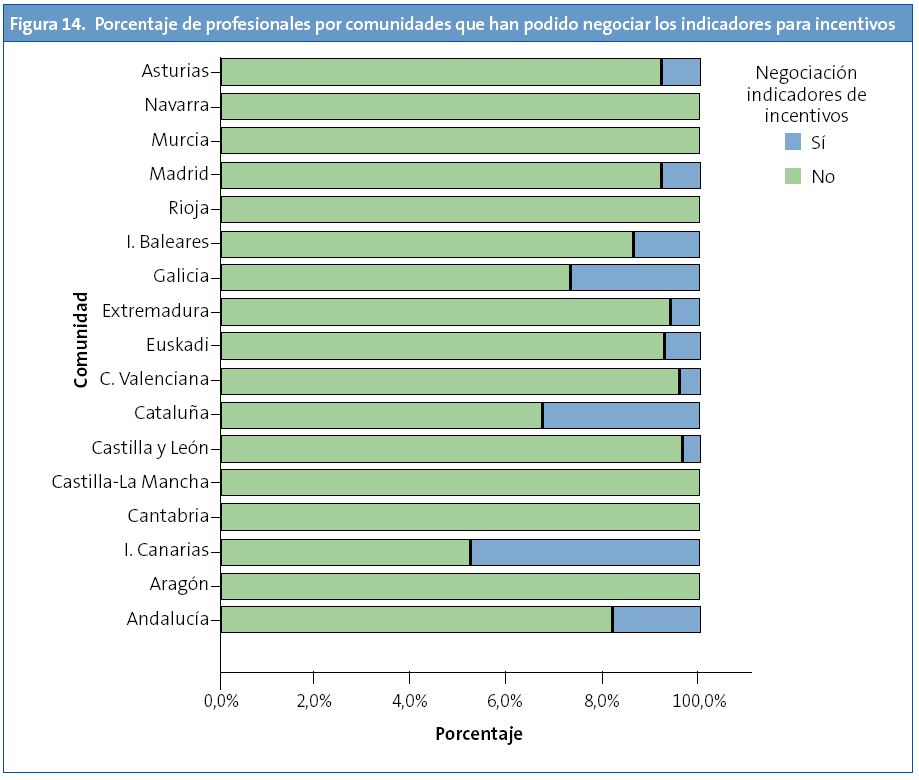
DISCUSIÓN
Las condiciones laborales de los profesionales en AP distan mucho de cumplir con unos requisitos mínimos que aseguren una correcta atención clínica, favoreciendo sin embargo el estrés profesional y el desgaste profesional que consecuentemente empeora dicha asistencia. Es preocupante comprobar que prácticamente todos los aspectos relacionados con las condiciones de trabajo presentan importantes deficiencias, tanto en las propias condiciones físicas del lugar de trabajo como en la escasez de recursos para la realización correcta de la actividad médica y en la importante sobrecarga asistencial. Por otra parte, los aspectos motivadores e incentivadores que podrían contrarrestar en algo los efectos de las anteriores condiciones negativas y paliar el posible estrés y desgaste profesional también son muy deficientes. Aspectos tan importantes para el desarrollo y la motivación profesional como la formación, la docencia y la investigación están absolutamente denostados, sin facilitar en nada su acceso y participación ni en tiempo ni en recursos. Tampoco parece resultar útil la incentivación económica, ya que la herramienta teóricamente diseñada para ello, como es la productividad variable (incentivos), no cumple su función, ya que ni se conocen los objetivos previamente la mayor parte de las veces, ni se pueden negociar individualmente en prácticamente la totalidad de los casos. El único aspecto positivo encontrado ha sido un porcentaje relativamente aceptable de posibilidad de conciliación de la vida familiar y laboral, aunque sería deseable que el 21% de profesionales que tiene dificultades para conseguir esta conciliación (en su mayoría por tener un turno de trabajo fijo en el horario que debería ocuparse de atender a su familia) tuvieran la posibilidad de algún tipo de flexibilidad que mejorara su situación.
CONCLUSIONES
En esta encuesta hemos detectado varios “puntos negros” en relación a las condiciones laborales de los pediatras, con importantes diferencias intercomunitarias en cada uno de los aspectos analizados (Tablas 4 a 6):
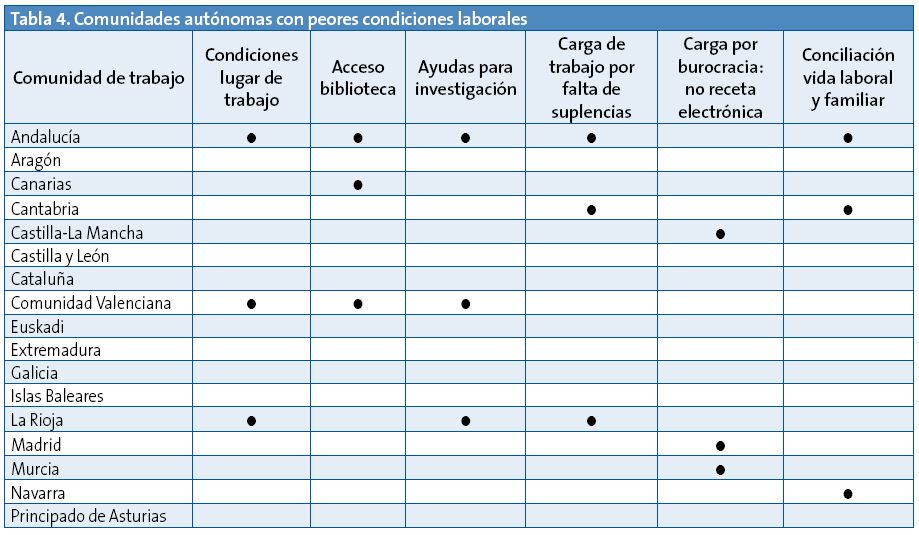
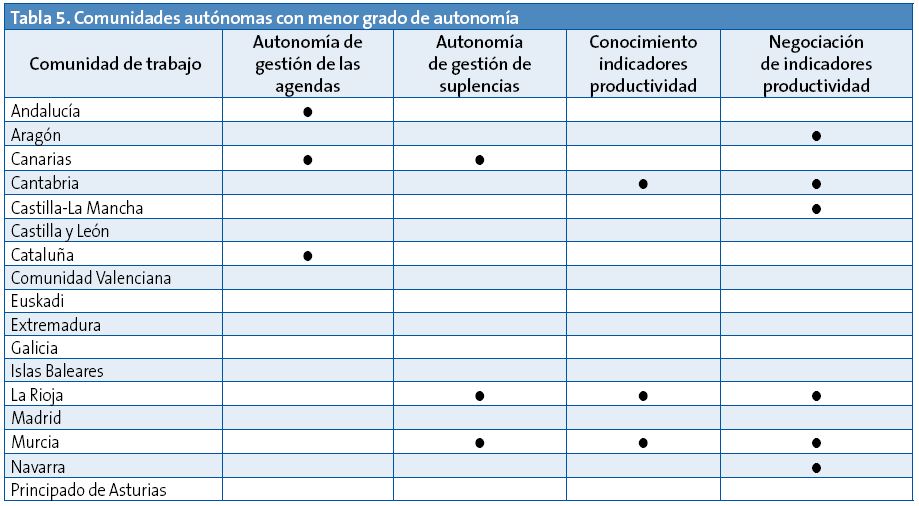

Condiciones del lugar de trabajo
- Cuatro de cada diez profesionales consideran que las condiciones de su consulta no les permiten la correcta realización de su trabajo (fundamentalmente medidas de seguridad, condiciones ergonómicas, de temperatura y ventilación de la sala, e incluso falta de material necesario para una correcta exploración en el 40% de los casos). Peores CC. AA.: Rioja, Andalucía y Valencia. Mejores CC. AA.: Navarra, Cantabria y Euskadi.
- La mitad no tiene acceso a pruebas complementarias que considera necesarias y accesibles desde AP.
- Solo un 30% tiene acceso a un servicio de investigación. Peores CC. AA.: Rioja, Andalucía y Valencia. Mejor CC. AA.: Baleares.
Distribución de tiempos en la jornada laboral
Ocho de cada diez PAP dedican más del 75% de su jornada a labores exclusivamente asistenciales (lo cual reduce enormemente el tiempo de dedicación a docencia, investigación y formación de residentes). Peores CC. AA.: Rioja y Cataluña. Mejores CC. AA.: Castilla-La Mancha y Asturias.
Cargas de trabajo
- El 60% de los pediatras tiene más de 1000 niños asignados y un 45% una presión asistencial superior a 30 pacientes/día de media, lo que supera con creces el número adecuado para garantizar un correcto desarrollo del proceso clínico.
- Hasta un tercio de los pediatras tienen que asumir la consulta completa del compañero durante periodos prolongados por falta de cobertura con suplentes. Peores CC. AA.: Rioja, Cantabria y Andalucía. Mejores CC. AA.: Baleares y Aragón.
Conciliación de la vida laboral y familiar
Casi el 80% de los profesionales considera que existen condiciones que facilitan la conciliación de la vida familiar y laboral. Cuando no es así, en el 90% de los casos es por tener que trabajar en un turno fijo en el horario en que debería ocuparse de su familia. Las CC. AA. donde más dificultades de conciliación se encuentran son Navarra y Cantabria, las que más la favorecen, Asturias y Castilla-La Mancha.
Autonomía de gestión
- Solo el 28% de los equipos tiene capacidad para autogestionar el presupuesto asignado para suplencias. Peores CC. AA.: Rioja y Canarias. Mejores CC. AA.: Madrid y Aragón.
- El 65% de los profesionales conocía los ítems que se iban a valorar para la consecución de objetivos de cara a la productividad variable, y solo un 9% de ellos había podido negociar sobre estos indicadores. Peores CC. AA.: Rioja, Cantabria y Murcia. Mejor CC. AA.: Canarias.
CONFLICTO DE INTERESES
Los autores declaran no presentar conflictos de intereses en relación con la preparación y publicación de este artículo.
ABREVIATURAS: AEPap: Asociación Española de Pediatría de Atención Primaria • AP: Atención Primaria • CC. AA.: comunidades autónomas • CS: centro de salud • EAP: Equipos de Atención Primaria • PAP: pediatras de Atención Primaria.
BIBLIOGRAFÍA
- García Perez MA. El ejercicio de la Medicina de Atención Primaria en España (Medicina General/de Familia y Pediatría). Antecedentes, situación actual y criterios para su desarrollo futuro. Madrid: Confederación Estatal de Sindicatos Médicos (eds.); 2010.
- Sánchez Pina C, Palomino Urda N, de Frutos Gallego E, Valdivia Jiménez C, Rodríguez Fernández-Oliva CR, Miranda Berrioategortua I, et al. “Puntos negros” de la asistencia a la población infantojuvenil en Atención Primaria en España (primera parte). Rev Pediatr Aten Primaria. 2011;13:15-31.
- Sánchez Pina C, Palomino Urda N, de Frutos Gallego E, Valdivia Jiménez C, Lorente García S, Bernad Usoz JV, et al. “Puntos negros” de la asistencia a la población infantojuvenil en Atención Primaria en España (segunda parte). Rev Pediatr Aten Primaria. 2011;13:e1-e14.
- Sánchez Díaz MD, García Vera C. La encuesta “PAPE”: panorámica de la pediatría de atención primaria en nuestro país. Rev Pediatr Aten Primaria Supl. 2013; (22): 35-42.





